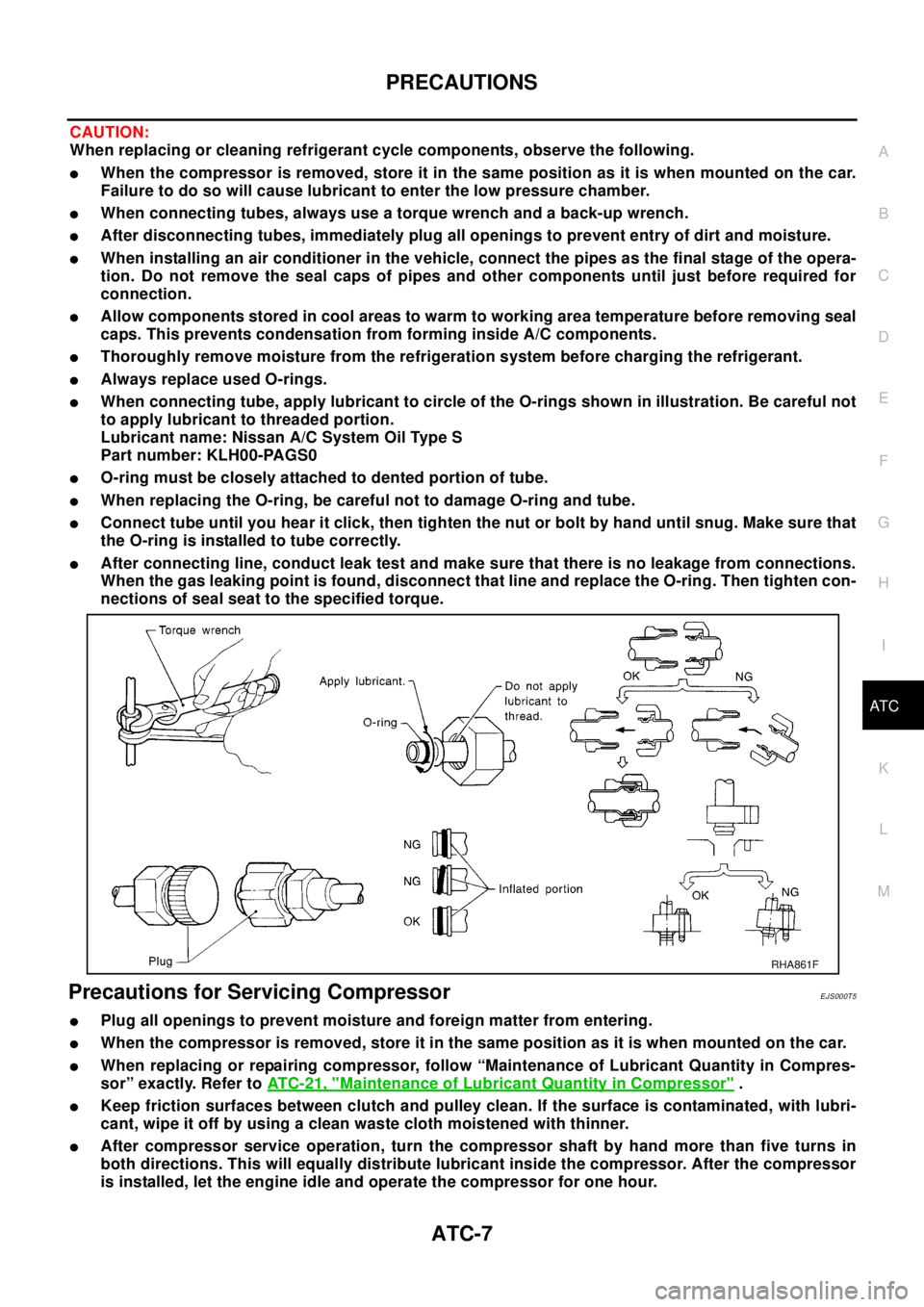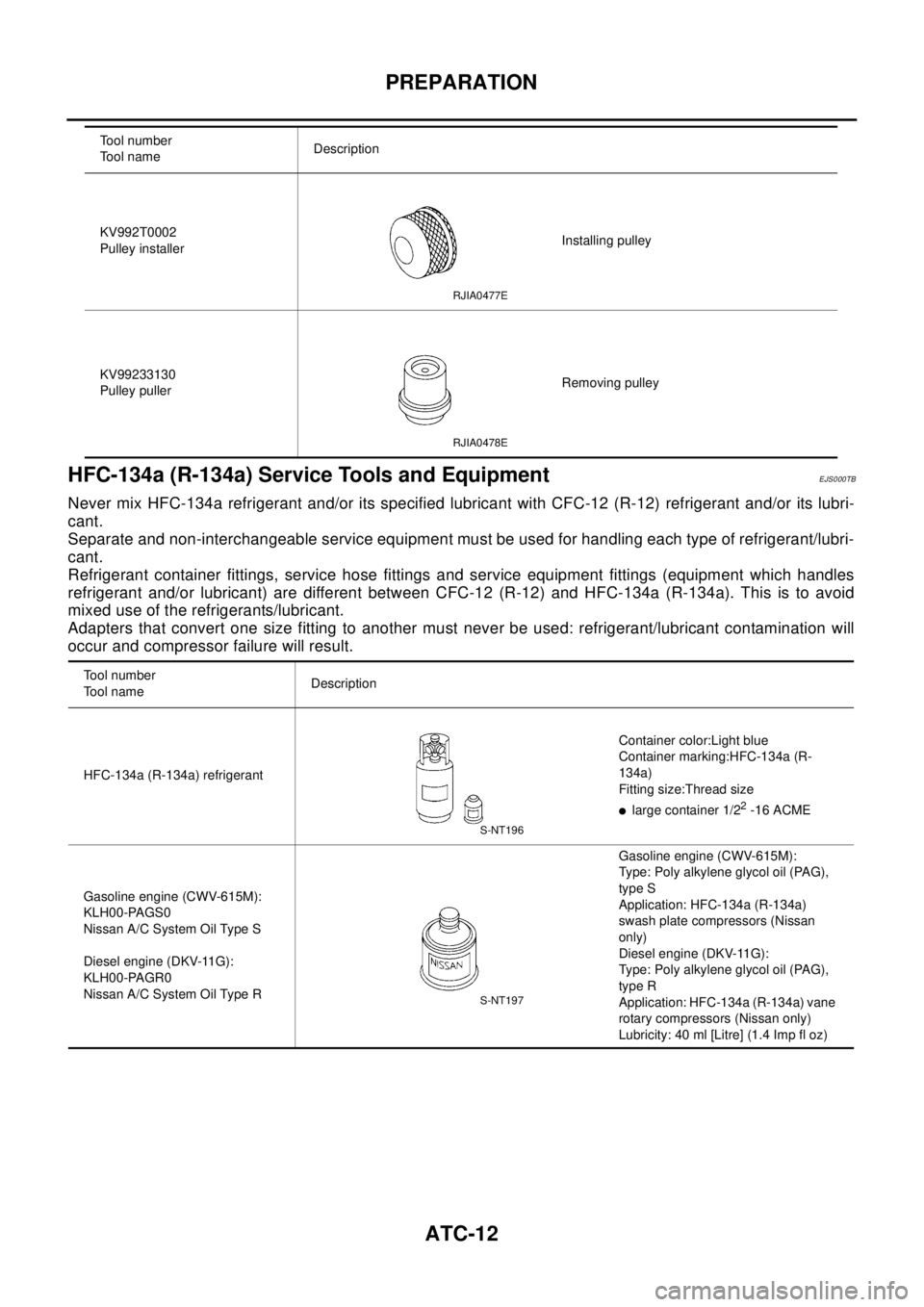2003 NISSAN X-TRAIL engine oil
[x] Cancel search: engine oilPage 430 of 3066
![NISSAN X-TRAIL 2003 Electronic Repair Manual AT-424
[ALL]
TORQUE CONVERTER CLUTCH SOLENOID VALVE
Diagnostic Procedure
ECS004U6
1.CHECK VALVE RESISTANCE
1. Turn ignition switch to “OFF” position.
2. Disconnect terminal cord assembly connector NISSAN X-TRAIL 2003 Electronic Repair Manual AT-424
[ALL]
TORQUE CONVERTER CLUTCH SOLENOID VALVE
Diagnostic Procedure
ECS004U6
1.CHECK VALVE RESISTANCE
1. Turn ignition switch to “OFF” position.
2. Disconnect terminal cord assembly connector](/manual-img/5/57402/w960_57402-429.png)
AT-424
[ALL]
TORQUE CONVERTER CLUTCH SOLENOID VALVE
Diagnostic Procedure
ECS004U6
1.CHECK VALVE RESISTANCE
1. Turn ignition switch to “OFF” position.
2. Disconnect terminal cord assembly connector in engine compartment.
3. Check resistance between terminal 5 and ground.
OK or NG
OK >> GO TO 2
NG >> 1. Remove oil pan. Refer toAT- 4 5 3 , "
Installation".
2. Check the following items:
Torque converter clutch solenoid valve
Refer to “Component Inspection”,AT-425, "
Compo-
nent Inspection".
Harness of terminal cord assembly for short or open
2.CHECK POWER SOURCE CIRCUIT
1. Turn ignition switch to “OFF” position.
2. Disconnect TCM harness connector.
3. Check continuity between terminal 5 and TCM harness connector terminal 3.
If OK, check harness for short to ground and short to power.
4. Reinstall any part removed.
OK or NG
OK >> GO TO 3
NG >> Repair open circuit or short to ground or short to power
in harness or connectors.
3.CHECK DTC
Perform Self-diagnosis Code confirmation procedure,AT - 4 2 1 , "
TORQUE CONVERTER CLUTCH SOLENOID
VA LV E".
OK or NG
OK >>INSPECTION END
NG >> 1. Perform TCM input/output signal inspection.
2. If NG, recheck TCM pin terminals for damage or loose connection with harness connector. Resistance : 5 - 20W
SCIA0731E
Continuity should exist.
SCIA0732E
Page 435 of 3066
![NISSAN X-TRAIL 2003 Electronic Repair Manual BATT/FLUID TEMP SEN (A/T FLUID TEMP SENSOR CIRCUIT AND TCM POW-
ER SOURCE)
AT-429
[ALL]
D
E
F
G
H
I
J
K
L
MA
B
AT
Diagnostic ProcedureECS004UA
1.CHECK TCM POWER SOURCE
1. Turn ignition switch to “ON NISSAN X-TRAIL 2003 Electronic Repair Manual BATT/FLUID TEMP SEN (A/T FLUID TEMP SENSOR CIRCUIT AND TCM POW-
ER SOURCE)
AT-429
[ALL]
D
E
F
G
H
I
J
K
L
MA
B
AT
Diagnostic ProcedureECS004UA
1.CHECK TCM POWER SOURCE
1. Turn ignition switch to “ON](/manual-img/5/57402/w960_57402-434.png)
BATT/FLUID TEMP SEN (A/T FLUID TEMP SENSOR CIRCUIT AND TCM POW-
ER SOURCE)
AT-429
[ALL]
D
E
F
G
H
I
J
K
L
MA
B
AT
Diagnostic ProcedureECS004UA
1.CHECK TCM POWER SOURCE
1. Turn ignition switch to “ON” position.
(Do not start engine.)
2. Check voltage between TCM terminals 10, 19, 28 and ground.
3. Turn ignition switch to “OFF” position.
4. Check voltage between TCM terminal 28 and ground.
OK or NG
OK >> GO TO 2
NG >> Check the following items:
lHarness for short or open between ignition switch and
TCM (Main harness)
lIgnition switch and fuse
Refer to “PG-2, "
POWER SUPPLY ROUTING"”,
“POWER SUPPLY ROUTING”.
2.CHECK A/T FLUID TEMPERATURE SENSOR WITH TERMINAL CORD ASSEMBLY
1. Turn ignition switch to “OFF” position.
2. Disconnect terminal cord assembly connector in engine compartment.
3. Check resistance between terminals 6 and 7 when A/T is cold.
4. Reinstall any part removed.
OK or NG
OK (With CONSULT-II)>>GO TO 3
OK (Without CONSULT-II)>>GO TO 4
NG >> 1. Remove oil pan.
2. Check the following items:
A/T fluid temperature sensor
Refer to “Component Inspection”,AT-431, "
Compo-
nent Inspection".
Harness of terminal cord assembly for short or open Voltage:Batteryvoltage
Voltage:Batteryvoltage
SCIA0736E
Resistance Cold[20°C(68°F)]
: Approximately 2.5 kW
SCIA0737E
Page 440 of 3066
![NISSAN X-TRAIL 2003 Electronic Repair Manual AT-434
[ALL]
ENGINE SPEED SIGNAL
Diagnostic Procedure
ECS004UE
1.CHECK DTC WITH ECM
Perform diagnostic test mode II (self-diagnostic results) for engine control. Check ignition signal circuit condi-
t NISSAN X-TRAIL 2003 Electronic Repair Manual AT-434
[ALL]
ENGINE SPEED SIGNAL
Diagnostic Procedure
ECS004UE
1.CHECK DTC WITH ECM
Perform diagnostic test mode II (self-diagnostic results) for engine control. Check ignition signal circuit condi-
t](/manual-img/5/57402/w960_57402-439.png)
AT-434
[ALL]
ENGINE SPEED SIGNAL
Diagnostic Procedure
ECS004UE
1.CHECK DTC WITH ECM
Perform diagnostic test mode II (self-diagnostic results) for engine control. Check ignition signal circuit condi-
tion.
OK or NG
OK (With CONSULT-II)>>GO TO 2
OK (Without CONSULT-II)>>GO TO 3
NG >> Check ignition signal circuit for engine control. Refer to “”, “DTC P1320 IGNITION SIGNAL”.
2.CHECK INPUT SIGNAL (WITH CONSULT-II)
With CONSULT-II
1. Start engine.
2. Select “TCM INPUT SIGNALS” in “DATA MONITOR” mode for
“A/T” with CONSULT-II.
3. Read out the value of “ENGINE SPEED”.
Check engine speed changes according to throttle position.
OK or NG
OK >> GO TO 4
NG >> Check the following items:
lHarness for short or open between TCM and ECM
lResistor and ignition coil
Refer to “”, “DTC P1320 IGNITION SIGNAL”.
3.CHECK INPUT SIGNAL (WITHOUT CONSULT-II)
Without CONSULT-II
1. Start engine.
2. Check voltage between TCM terminal 39 and ground.
OK or NG
OK >> GO TO 4
NG >> Check the following items:
lHarness for short or open between TCM and ECM
lResistor and ignition coil
Refer to “”, “DTC P1320 IGNITION SIGNAL”.
SAT014K
SAT645J
Voltage (Idle speed):
Refer to “”, “DTC P1320 IGNITION SIGNAL”.
SCIA0740E
Page 442 of 3066
![NISSAN X-TRAIL 2003 Electronic Repair Manual AT-436
[ALL]
LINE PRESSURE SOLENOID VALVE
LINE PRESSURE SOLENOID VALVE
PFP:31940
DescriptionECS004UF
The line pressure solenoid valve regulates the oil pump discharge
pressure to suit the driving cond NISSAN X-TRAIL 2003 Electronic Repair Manual AT-436
[ALL]
LINE PRESSURE SOLENOID VALVE
LINE PRESSURE SOLENOID VALVE
PFP:31940
DescriptionECS004UF
The line pressure solenoid valve regulates the oil pump discharge
pressure to suit the driving cond](/manual-img/5/57402/w960_57402-441.png)
AT-436
[ALL]
LINE PRESSURE SOLENOID VALVE
LINE PRESSURE SOLENOID VALVE
PFP:31940
DescriptionECS004UF
The line pressure solenoid valve regulates the oil pump discharge
pressure to suit the driving condition in response to a signal sent
from the TCM.
The line pressure duty cycle value is not consistent when the
closed throttle position switch is “ON”. To confirm the line
pressure duty cycle at low pressure, the accelerator (throttle)
should be open until the closed throttle position switch is
“OFF”.
CONSULT-II REFERENCE VALUE IN DATA MONITOR MODE
Remarks: Specification data are reference values.
NOTE:
The line pressure duty cycle value is not consistent when the closed throttle position switch is “ON”. To confirm the line pressure duty
cycle at low pressure, the accelerator (throttle) should be open until the closed throttle position switch is “OFF”.
TCM TERMINALS AND REFERENCE VALUE
Remarks: Specification data are reference values.
ON BOARD DIAGNOSIS LOGIC
SELF-DIAGNOSIS CODE CONFIRMATION PROCEDURE
After the repair, perform the following procedure to confirm the malfunction is eliminated.
SCIA0735E
Monitor item Condition Specification
Line pressure solenoid valve dutySmall throttle opening
(Low line pressure)
¯
Large throttle opening
(High line pressure)Approximately 24%
¯
Approximately 95%
Te r m i -
nal No.Wire color Item ConditionJudgement stan-
dard
(Approx.)
1R/WLine pressure
solenoid valveWhen releasing accelerator pedal
after warming up engine.1.5 - 3.0V
When depressing accelerator pedal
fully after warming up engine.0V
2P/BLine pressure
solenoid valve
(with dropping
resistor)When releasing accelerator pedal
after warming up engine.5-14V
When depressing accelerator pedal
fully after warming up engine.0V
Diagnostic trouble code Malfunction is detected when... Check items (Possible cause)
: LINE PRESSURE S/V
TCM detects an improper voltage drop
when it tries to operate the solenoid valve.
lHarness or connectors
(The solenoid circuit is open or shorted.)
lLine pressure solenoid valve
: 10th judgement flicker
Page 464 of 3066
![NISSAN X-TRAIL 2003 Electronic Repair Manual AT-458
[ALL]
REMOVAL AND INSTALLATION
REMOVAL AND INSTALLATION
PFP:00000
RemovalECS004NC
CAUTION:
Before separating transaxle from engine, remove the crankshaft position sensor (Euro-OBD) from
transax NISSAN X-TRAIL 2003 Electronic Repair Manual AT-458
[ALL]
REMOVAL AND INSTALLATION
REMOVAL AND INSTALLATION
PFP:00000
RemovalECS004NC
CAUTION:
Before separating transaxle from engine, remove the crankshaft position sensor (Euro-OBD) from
transax](/manual-img/5/57402/w960_57402-463.png)
AT-458
[ALL]
REMOVAL AND INSTALLATION
REMOVAL AND INSTALLATION
PFP:00000
RemovalECS004NC
CAUTION:
Before separating transaxle from engine, remove the crankshaft position sensor (Euro-OBD) from
transaxle. Be careful not to damage sensor.
1. Remove battery and bracket, air cleaner and air duct.
2. Remove air breather hose.
3. Disconnect A/T solenoid valve harness connector, PNP switch harness connector and revolution sensor
harness connector.
4. Remove crankshaft position sensor (Euro-OBD) from transaxle.
5. Disconnect control cable from transaxle.
6. Remove front exhaust tube.
7. Disconnect oil cooler hoses.
8. Remove drive shafts. Refer toFAX-11, "
FRONT DRIVE
SHAFT",RAX-9, "REAR DRIVE SHAFT".
9. Remove transfer. Refer toTF-12, "
TRANSFER ASSEMBLY".
10. Remove starter motor from transaxle.
11. Support transaxle with a jack.
SCIA0793E
ATM0479D
Page 585 of 3066

PRECAUTIONS
ATC-7
C
D
E
F
G
H
I
K
L
MA
B
AT C
CAUTION:
When replacing or cleaning refrigerant cycle components, observe the following.
lWhen the compressor is removed, store it in the same position as it is when mounted on the car.
Failure to do so will cause lubricant to enter the low pressure chamber.
lWhen connecting tubes, always use a torque wrench and a back-up wrench.
lAfter disconnecting tubes, immediately plug all openings to prevent entry of dirt and moisture.
lWhen installing an air conditioner in the vehicle, connect the pipes as the final stage of the opera-
tion. Do not remove the seal caps of pipes and other components until just before required for
connection.
lAllow components stored in cool areas to warm to working area temperature before removing seal
caps. This prevents condensation from forming inside A/C components.
lThoroughly remove moisture from the refrigeration system before charging the refrigerant.
lAlways replace used O-rings.
lWhen connecting tube, apply lubricant to circle of the O-rings shown in illustration. Be careful not
to apply lubricant to threaded portion.
Lubricant name: Nissan A/C System Oil Type S
Part number: KLH00-PAGS0
lO-ring must be closely attached to dented portion of tube.
lWhen replacing the O-ring, be careful not to damage O-ring and tube.
lConnect tube until you hear it click, then tighten the nut or bolt by hand until snug. Make sure that
the O-ring is installed to tube correctly.
lAfter connecting line, conduct leak test and make sure that there is no leakage from connections.
When the gas leaking point is found, disconnect that line and replace the O-ring. Then tighten con-
nections of seal seat to the specified torque.
Precautions for Servicing CompressorEJS000T5
lPlug all openings to prevent moisture and foreign matter from entering.
lWhen the compressor is removed, store it in the same position as it is when mounted on the car.
lWhen replacing or repairing compressor, follow “Maintenance of Lubricant Quantity in Compres-
sor” exactly. Refer toATC-21, "
Maintenance of Lubricant Quantity in Compressor".
lKeep friction surfaces between clutch and pulley clean. If the surface is contaminated, with lubri-
cant, wipe it off by using a clean waste cloth moistened with thinner.
lAfter compressor service operation, turn the compressor shaft by hand more than five turns in
both directions. This will equally distribute lubricant inside the compressor. After the compressor
is installed, let the engine idle and operate the compressor for one hour.
RHA861F
Page 590 of 3066

ATC-12
PREPARATION
HFC-134a (R-134a) Service Tools and Equipment
EJS000TB
Never mix HFC-134a refrigerant and/or its specified lubricant with CFC-12 (R-12) refrigerant and/or its lubri-
cant.
Separate and non-interchangeable service equipment must be used for handling each type of refrigerant/lubri-
cant.
Refrigerant container fittings, service hose fittings and service equipment fittings (equipment which handles
refrigerant and/or lubricant) are different between CFC-12 (R-12) and HFC-134a (R-134a). This is to avoid
mixed use of the refrigerants/lubricant.
Adapters that convert one size fitting to another must never be used: refrigerant/lubricant contamination will
occur and compressor failure will result.
KV992T0002
Pulley installerInstalling pulley
KV99233130
Pulley pullerRemoving pulley Tool number
Tool nameDescription
RJIA0477E
RJIA0478E
Tool number
Tool nameDescription
HFC-134a (R-134a) refrigerantContainer color:Light blue
Container marking:HFC-134a (R-
134a)
Fitting size:Thread size
llarge container 1/22-16 ACME
Gasoline engine (CWV-615M):
KLH00-PAGS0
Nissan A/C System Oil Type S
Diesel engine (DKV-11G):
KLH00-PAGR0
Nissan A/C System Oil Type RGasoline engine (CWV-615M):
Type: Poly alkylene glycol oil (PAG),
type S
Application: HFC-134a (R-134a)
swash plate compressors (Nissan
only)
Diesel engine (DKV-11G):
Type: Poly alkylene glycol oil (PAG),
type R
Application: HFC-134a (R-134a) vane
rotary compressors (Nissan only)
Lubricity: 40 ml [Litre] (1.4 Imp fl oz)
S-NT196
S-NT197
Page 594 of 3066

ATC-16
REFRIGERATION SYSTEM
REFRIGERATION SYSTEM
PFP:KA990
Refrigerant CycleEJS000TD
REFRIGERANT FLOW
The refrigerant flows in the standard pattern, that is, through the compressor, the condenser with liquid tank,
through the evaporator, and back to the compressor. The refrigerant evaporation through the evaporator coil is
controlled by an externally equalized expansion valve, located inside the evaporator case.
FREEZE PROTECTION (WITH GASOLINE ENGINE: CWV-615M COMPRESSOR)
Under normal operating conditions, when the A/C is switched on, the compressor runs continuously, and the
evaporator pressure, and therefore, temperature is controlled by the V-6 variable displacement compressor to
prevent freeze up.
Refrigerant System ProtectionEJS000TE
REFRIGERANT PRESSURE SENSOR (WITH GASOLINE ENGINE: CWV-615M COMPRESSOR)
The refrigerant system is protected against excessively high or low pressures by the refrigerant pressure sen-
sor, located on the liquid tank. If the system pressure rises above, or falls below the specifications, the refriger-
ant pressure sensor detects the pressure inside the refrigerant line and sends the voltage signal to the ECM.
ECM makes the A/C relay go OFF and stops the compressor when pressure on the high pressure side
detected by refrigerant pressure sensor is over about 2,746 kPa (28 kg/cm
2, 398 psi), or below about 134 kPa
(1.4 kg/cm
2,20psi).
DUAL-PRESSURE SWITCH (WITH DIESEL ENGINE: DKV-11G COMPRESSOR)
The refrigerant system is protected against excessively high or low pressures by the dual-pressure switch,
located on the liquid tank. If the system pressure rises above or falls below the specifications, the dual-pres-
sure switch opens to interrupt the compressor operation.
PRESSURE RELIEF VALVE (WITH GASOLINE ENGINE: CWV-615M COMPRESSOR)
The refrigerant system is also protected by a pressure relief valve, located in the rear head of the compressor.
When the pressure of refrigerant in the system increases to an abnormal level [more than 3,727 kPa (38 kg/